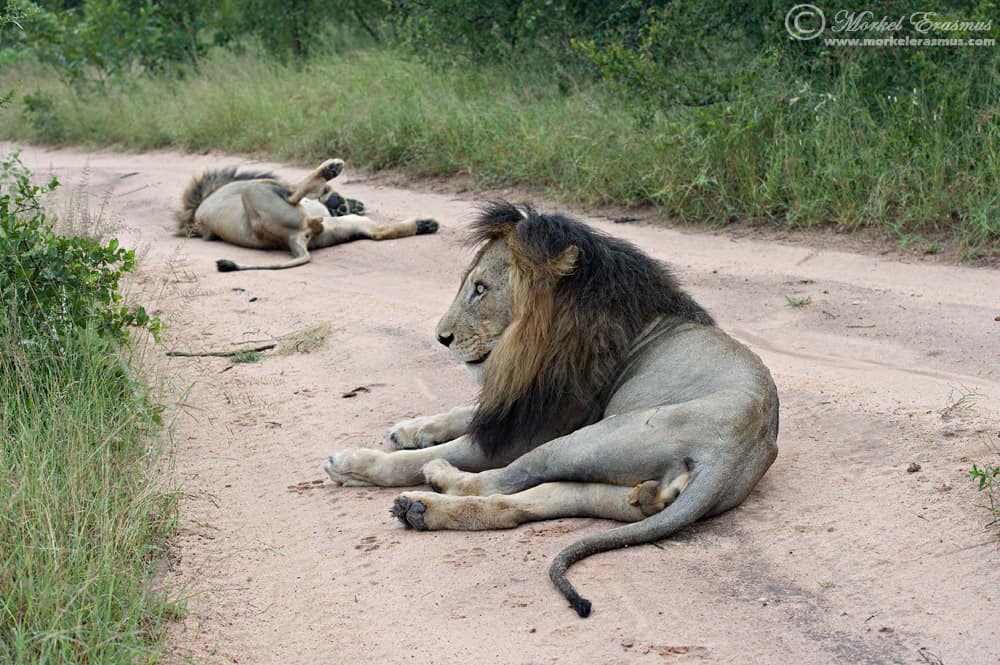We were awoken in the early hours of the morning by the persistent (and close-by) roaring of male lions. I knew we were in the general territory of the infamous Mapogo male coalition, and a hope was ignited to perhaps see them on our morning drive.
Our wake-up call came, and with a quick coffee in our bellies we set out and our tracker picked up the lion spoor just outside of the lodge. It wasn’t long before we came around a bend in the road to be greeted by this sight.
They were being pretty useless, but it was awesome nonetheless to spend time with them.
Have you ever been THIS lazy?? Check out this badboy just peeing over himself, too lazy to get up and do it properly!
We drove around them for another view…but it was more of the same…
We decided to move on – and wisely so. First off we found a lone impala standing in the middle of a dam/waterhole of some sorts. Our first thought was that Painted Dogs or Spotted Hyaenas had chased it in there, but after sitting with it for more than 30 minutes with no pursuer appearing, we decided to go and search for leopards…which we found!
The leopardess Mambirri was moving along a drainage line with her yearling cub, and we headed to a suitable point to “intercept” (PS: Mambirri has since passed on, and you can read a lovely tribute with great images by my friend Rudi Hulshof on his blog HERE).
We found a great spot thanks to Marius Coetzee’s knowledge of the leopard routines of the area…and we were able to enjoy a quality sighting on our last morning in the Sabi Sands.
The cub was curious and as they sauntered down the road into the drainage line she checked out some scents she picked up…
They moved into the drainage line and across some large riverine boulders…
They then disappeared into a thicket. We circled around, again based on Marius’ knowledge/hunch of where they were headed…and after waiting a little while they popped up where he said they would.
We were hoping they would come and play on a very photogenic hardwood stump in front of us, but for some reason they turned around and headed back the same way they came…
We stayed with them until Mambirri left her cub in a thicket to go off and hunt…although we were primarily behind them for the rest of this sighting, so photographs are few and far between. We headed back to the lodge for our last lunch before departing – it was a wonderful time, and I am grateful for having had this experience. We latched a couple of days in the Kruger National Park on the back of this trip, but I will leave that for another report.
We are busy ironing out the details of a return visit to Leopard Hills Private Game Reserve – and I can’t wait to see how the big cat dynamics have changed in the Western Sabi Sands in these 4 years!
Thanks for following along.
Morkel Erasmus
Morkel Erasmus
I used to relish writing these kinds of “bio” pieces and would flaunt the odd impressive word and use dashing grammar to make it sound like I am a boundary-shifting photographer. These days I prefer stating it in much simpler ways, much more relatable ways, much more believable ways… The fact of the matter is this: I love Africa. I love its people, its wild places and its wildlife. I love being immersed in these places, observing and photographing the fall of light on the land and the daily lives of the creatures that call it home, and presenting the results to whoever will take a look. To me, nature photography is all about being in the moment, and capturing that moment in a way that can relate to someone who didn’t have the privilege of being there with me. Sometimes I am able to capture a unique vision of the scene before me, and sometimes I just capture it the way most folks would according to classical photographic guidelines. Yet I always enjoy sharing the images and experiences and imparting the knowledge I have, both in-the-field and later online or in presentations, workshops and courses. I also just simply enjoy capturing and sharing the beauty of God's creation! The greatest thing I’ve found about wildlife and nature photography in Southern Africa is the unity and familiarity of the community of people that share this passion. We come from all walks of life and all cultures and backgrounds, yet our passion for our natural heritage and our dream to see it preserved for future generations binds strangers together and fuels conversations around campfires long after other people have run out of conversation and energy. Join me on a WildEye adventure to experience this sharing community spirit and learn to anticipate that fleeting moment and be ready for it, learn to immerse yourself in the experience without losing focus of your photographic goals…and above all, learn to see Africa anew… because there are none as blind as those who look but do not see!
- Web |
- More Posts(111)
















Leave a Reply